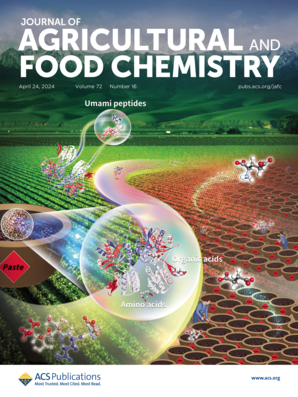Glutathione S-Transferase Gene GST1 Metabolizing Penoxsulam and Conferring Penoxsulam Resistance in Echinochloa phyllopogon
IF 5.7
1区 农林科学
Q1 AGRICULTURE, MULTIDISCIPLINARY
引用次数: 0
Abstract
Echinochloa phyllopogon, a malignant weed found in paddy fields, has developed resistance to many acetolactate synthase-inhibiting herbicides. This resistance threatens the effectiveness and sustainability of herbicides. Glutathione S-transferases (GSTs) are important detoxification enzymes responsible for herbicide resistance in plants. Here, we identified and characterized two GST genes (EpGST1 and EpGSTU6) that showed higher expression levels in resistant than in susceptible E. phyllopogon populations. Nucleotide sequence alignment showed that EpGST1 was identical in both the sensitive and resistant populations without any mutations. The HPLC-MS/MS results showed that the in vitro recombinant GST1 protein had a stronger ability to metabolize the herbicide penoxsulam than the empty vector or EpGSTU6. Overexpression of EpGST1 in Arabidopsis and rice significantly enhanced penoxsulam resistance. Peroxidase, superoxide dismutase, and catalase activities in the resistant population were significantly enhanced after penoxsulam treatment, and the contents of MDA were significantly increased. Similarly, in rice overexpressing EPGST1, the activities of the antioxidant enzymes peroxidase, superoxide dismutase, and catalase were significantly enhanced, and the contents of H2O2 were significantly decreased. The results of the subcellular localization study indicated that EpGST1 is a nuclear gene. These results suggest that EpGST1 plays a significant role in the evolution of penoxsulam resistance by enhancing herbicide metabolism in E. phyllopogon.

谷胱甘肽s -转移酶基因GST1代谢培诺舒南并赋予培诺舒南抗性
摘要水田恶性杂草毛条棘球藻对多种抑制乙酰乳酸合酶的除草剂产生了抗性。这种抗性威胁到除草剂的有效性和可持续性。谷胱甘肽s -转移酶(GSTs)是植物抗除草剂的重要解毒酶。在这里,我们鉴定并鉴定了两个GST基因(EpGST1和EpGSTU6),它们在抗性群体中的表达水平高于易感群体。核苷酸序列比对表明,EpGST1在敏感群体和抗性群体中完全相同,无突变。HPLC-MS/MS结果表明,体外重组GST1蛋白对除草剂培诺舒兰的代谢能力强于空载体或EpGSTU6。EpGST1在拟南芥和水稻中的过表达显著增强了对培诺舒南的抗性。培诺舒朗处理后,抗性群体过氧化物酶、超氧化物歧化酶和过氧化氢酶活性显著增强,MDA含量显著升高。同样,在过表达EPGST1的水稻中,抗氧化酶过氧化物酶、超氧化物歧化酶和过氧化氢酶的活性显著增强,H2O2含量显著降低。亚细胞定位研究结果表明,EpGST1是一个核基因。这些结果表明,EpGST1通过促进叶根对除草剂的代谢,在叶根对培诺舒南的抗性进化中发挥了重要作用。
本文章由计算机程序翻译,如有差异,请以英文原文为准。
求助全文
约1分钟内获得全文
求助全文
来源期刊
CiteScore
9.90
自引率
8.20%
发文量
1375
审稿时长
2.3 months
期刊介绍:
The Journal of Agricultural and Food Chemistry publishes high-quality, cutting edge original research representing complete studies and research advances dealing with the chemistry and biochemistry of agriculture and food. The Journal also encourages papers with chemistry and/or biochemistry as a major component combined with biological/sensory/nutritional/toxicological evaluation related to agriculture and/or food.

 求助内容:
求助内容: 应助结果提醒方式:
应助结果提醒方式:


